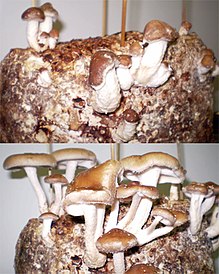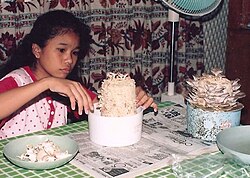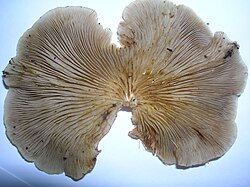Fungiculture is the process of producing food, medicine, and other products by the cultivation of mushrooms and other fungi.
The word is also commonly used to refer to the practice of cultivating fungi by leafcutter ants, termites, ambrosia beetles, and marsh periwinkles.
Instead of seeds, mushrooms reproduce asexually through spores. Spores can be contaminated with airborne microorganisms, which will interfere with mushroom growth and prevent a healthy crop.
Mycelium, or actively growing mushroom culture, is placed on a substrate—usually sterilized grains such as rye or millet—and induced to grow into those grains. This is called inoculation. Inoculated grains are referred to as spawn. Spores are another inoculation option, but are less developed than established mycelium. Since they are also contaminated easily, they are only manipulated in laboratory conditions with a laminar flow cabinet.
Due to its climate, the Pacific Northwest of the USA produces commercially valuable mushrooms. Valued species include:[3][4]
There are significant disadvantages to relying on natural mushroom production. These sales may be unregulated, placing buyers at risk for buying toxic or inedible mushrooms. By honest error, harvests may include toxic or inedible species. No controls exist to regulate the quality or frequency of harvests, since gatherers rely on favorable natural conditions and weather to produce fruiting. Conflicts may arise between competing gatherers trying to harvest from the same location.
State parks in the Pacific Northwest or elsewhere may charge fees for mushroom gathering permits.[5][6] Appalachia also produces edible wild mushrooms, including chanterelles and morels.[7] Pickers may sell directly to distributors, restaurants, or sell their harvest through roadside stands wherever a natural supply of mushrooms is plentiful.
While there may be concern that harvesting wild mushrooms may exploit or damage a natural environment, harvesting wild mushrooms is different from harvesting wild plants, fishing or hunting animals. In these last three cases, removing individuals decreases the ability of a wild population to reproduce, since fewer adults remain. Removing adults leaves fewer individuals capable of reproducing and reduces genetic diversity.
Harvesting wild mushrooms removes only fruiting bodies and their attached spores. However, the fruiting bodies (mushrooms) have likely dropped spores before harvest time, or will likely drop them en route to the harvester's destination, further expanding the fungi's habitat. Arguably, the practice of mushroom harvesting may actually help the species being harvested. While truffles also represent the fruiting body of a larger underground network, they are an exception, since they rely on animal spore dispersion.
Additionally, reproduction and propagation can still occur by propagation of the parent mycelium. Harvesting removes none of the parent mycelium, which remains intact underground.
Indoor tray growing is the most common commercial technique, followed by containerized growing. The tray technique provides the advantages of scalability and easier harvesting. Unlike wild harvests, indoor techniques provide tight control over growing substrate composition and growing conditions. Indoor harvests are much more predictable.
According to Daniel Royse and Robert Beelman, "[Indoor] Mushroom farming consists of six steps, and although the divisions are somewhat arbitrary, these steps identify what is needed to form a production system. The six steps are phase I composting, phase II fertilizing, spawning, casing, pinning, and cropping."[13][14]
Complete sterilization is not always required or performed during composting. In some cases, a pasteurization step is not included to allow some beneficial microorganisms to remain in the growth substrate.[13]
Specific time spans and temperatures required during stages 3–6 will vary respective to species and variety. Substrate composition and the geometry of growth substrate will also affect the ideal times and temperatures.
Pinning is the trickiest part for a mushroom grower, since a combination of carbon dioxide (CO2) concentration, temperature, light, and humidity triggers mushrooms towards fruiting.[1][2][13] Up until the point whenrhizomorphs or mushroom "pins" appear, the mycelium is an amorphous mass spread throughout the growth substrate, unrecognizable as a mushroom.
Carbon dioxide concentration becomes elevated during the vegetative growth phase, when mycelium is sealed in a gas-resistant plastic barrier or bag which traps gases produced by the growing mycelium. To induce pinning, this barrier is opened or ruptured. CO2 concentration then decreases from about 0.08% to 0.04%, the ambient atmospheric level.[13]
An ideal substrate will contain enough nitrogen and carbohydrate for rapid mushroom growth. Common bulk substrates include:[12][14]
A recent epidemic of Trichoderma green mold has significantly affected mushroom production: "From 1994-96, crop losses in Pennsylvania ranged from 30 to 100%".[20]




Details of the gill structure of the edible oyster mushroom Pleurotus ostreatus.[21]
The borough of Kennett Square is a historical and present leader in mushroom production. It currently leads production of Agaricus-type mushrooms,[23] followed by California, Florida and Michigan.[24]
Other mushroom-producing states:[25]
The word is also commonly used to refer to the practice of cultivating fungi by leafcutter ants, termites, ambrosia beetles, and marsh periwinkles.
Contents
[hide]Introduction[edit]
Mushrooms are not plants, and require different conditions for optimal growth. Plants develop through photosynthesis, a process that converts atmospheric carbon dioxide into carbohydrates, especially cellulose. Whilesunlight provides an energy source for plants, mushrooms derive all of their energy and growth materials from their growth medium, through biochemical decomposition processes. This does not mean that light is an irrelevant requirement, since some fungi use light as a signal for fruiting.[1][2] However, all the materials for growth must already be present in the growth medium. Mushrooms grow well at relative humidity levels of around 95-100%, and substrate moisture levels of 50 to 75%.[1]Instead of seeds, mushrooms reproduce asexually through spores. Spores can be contaminated with airborne microorganisms, which will interfere with mushroom growth and prevent a healthy crop.
Mycelium, or actively growing mushroom culture, is placed on a substrate—usually sterilized grains such as rye or millet—and induced to grow into those grains. This is called inoculation. Inoculated grains are referred to as spawn. Spores are another inoculation option, but are less developed than established mycelium. Since they are also contaminated easily, they are only manipulated in laboratory conditions with a laminar flow cabinet.
Techniques[edit]
All mushroom growing techniques require the correct combination of humidity, temperature, substrate (growth medium) and inoculum (spawn or starter culture). Wild harvests, outdoor log inoculation and indoor trays all provide these elements.Wild harvesting[edit]
| The neutrality of this article is questioned because of its systemic bias. In particular, there may be a strong bias in favor of USA. (February 2014) |
- American matsutake or pine mushroom (Tricholoma magnivelare)
- Chanterelles (Cantharellus formosus, Cantharellus subalbidus, and Cantharellus cibarius)
- Horn of plenty (Craterellus cornucopioides)
- Boletes (Boletus edulis and others)
- Truffles (Tuber gibbosum and Leucangium carthusiana)
- Hedgehogs / "spreading-hedgehog mushroom" (Hydnum repandum)
- Edible morel (Morchella esculenta)
- Coral tooth mushroom (Hericium abietis)
- Shaggy parasol (Lepiota rhacodes)
- Black picoa (Picoa carthusiana)
- Cauliflower mushroom (Sparassis crispa)
There are significant disadvantages to relying on natural mushroom production. These sales may be unregulated, placing buyers at risk for buying toxic or inedible mushrooms. By honest error, harvests may include toxic or inedible species. No controls exist to regulate the quality or frequency of harvests, since gatherers rely on favorable natural conditions and weather to produce fruiting. Conflicts may arise between competing gatherers trying to harvest from the same location.
State parks in the Pacific Northwest or elsewhere may charge fees for mushroom gathering permits.[5][6] Appalachia also produces edible wild mushrooms, including chanterelles and morels.[7] Pickers may sell directly to distributors, restaurants, or sell their harvest through roadside stands wherever a natural supply of mushrooms is plentiful.
While there may be concern that harvesting wild mushrooms may exploit or damage a natural environment, harvesting wild mushrooms is different from harvesting wild plants, fishing or hunting animals. In these last three cases, removing individuals decreases the ability of a wild population to reproduce, since fewer adults remain. Removing adults leaves fewer individuals capable of reproducing and reduces genetic diversity.
Harvesting wild mushrooms removes only fruiting bodies and their attached spores. However, the fruiting bodies (mushrooms) have likely dropped spores before harvest time, or will likely drop them en route to the harvester's destination, further expanding the fungi's habitat. Arguably, the practice of mushroom harvesting may actually help the species being harvested. While truffles also represent the fruiting body of a larger underground network, they are an exception, since they rely on animal spore dispersion.
Additionally, reproduction and propagation can still occur by propagation of the parent mycelium. Harvesting removes none of the parent mycelium, which remains intact underground.
Outdoor logs[edit]
Mushrooms can be grown on logs placed outdoors in stacks or piles, as has been done for hundreds of years.[8] Sterilization is not performed in this method. Since production may be unpredictable and seasonal, less than 5% of commercially sold mushrooms are produced this way.[9] Here, tree logs are inoculated with spawn, then allowed to grow as they would in wild conditions. Fruiting, or pinning, is triggered by seasonal changes, or by briefly soaking the logs in cool water.[8] Shiitake and oyster mushrooms have traditionally been produced using the outdoor log technique, although controlled techniques such as indoor tray growing or artificial logs made of compressed substrate have been substituted.[9][10][11]Indoor trays[edit]
Indoor growing provides the ability to tightly regulate light, temperature and humidity while excluding contaminants and pests. This allows consistent production, regulated by spawning cycles.[12] This is typically accomplished in windowless, purpose-built buildings, for large scale commercial production.Indoor tray growing is the most common commercial technique, followed by containerized growing. The tray technique provides the advantages of scalability and easier harvesting. Unlike wild harvests, indoor techniques provide tight control over growing substrate composition and growing conditions. Indoor harvests are much more predictable.
According to Daniel Royse and Robert Beelman, "[Indoor] Mushroom farming consists of six steps, and although the divisions are somewhat arbitrary, these steps identify what is needed to form a production system. The six steps are phase I composting, phase II fertilizing, spawning, casing, pinning, and cropping."[13][14]
Six phases of mushroom cultivation[edit]
| Phase | Time span | Temperature | Key points |
|---|---|---|---|
| 1. Phase I composting | 6–14 days[13] | Regulate water and NH3 content through microbial action.Add fertilizer / additives | |
| 2. Phase II composting or pasteurization | 7–18 days via composting method, ~2 hours for pasteurization (heat sterilization)[14] | Reduce number of potentially harmful microbes through further composting, or apply heat sterilization.Remove unwanted NH3. | |
| 3. Spawning and growth | 14–21 days[14] | 75°F; to 80°F; must be above 74°F; for rapid growth.[13]Must be below 80°F; to 85°F to avoid damaging mycelia[14] | Add starter culture.Allow mycelium to grow through substrate and form a colony. Depends on substrate dimensions and composition. Finished when mycelium has propagated through entire substrate layer |
| 4. Casing | 13–20 days | Promote the formation of promordia, or mushroom pins.Add a top covering or dressing to the colonized substrate. Fertilizing with nitrogen increases yields. Induces pinning | |
| 5. Pinning | 18–21 days[13] | Earliest formation of recognizable mushrooms from mycelium.Adjusting temperature, humidity and CO2 will also affect the number of pins, and mushroom size | |
| 6. Cropping | Repeated over 7-10 day cycles[14] | Harvest |
Specific time spans and temperatures required during stages 3–6 will vary respective to species and variety. Substrate composition and the geometry of growth substrate will also affect the ideal times and temperatures.
Pinning is the trickiest part for a mushroom grower, since a combination of carbon dioxide (CO2) concentration, temperature, light, and humidity triggers mushrooms towards fruiting.[1][2][13] Up until the point whenrhizomorphs or mushroom "pins" appear, the mycelium is an amorphous mass spread throughout the growth substrate, unrecognizable as a mushroom.
Carbon dioxide concentration becomes elevated during the vegetative growth phase, when mycelium is sealed in a gas-resistant plastic barrier or bag which traps gases produced by the growing mycelium. To induce pinning, this barrier is opened or ruptured. CO2 concentration then decreases from about 0.08% to 0.04%, the ambient atmospheric level.[13]
Substrates[edit]
Mushroom production converts the raw natural ingredients into mushroom tissue, most notably the carbohydrate chitin.[1]An ideal substrate will contain enough nitrogen and carbohydrate for rapid mushroom growth. Common bulk substrates include:[12][14]
- Wood chips or sawdust
- Mulched straw (usually wheat, but also rice and other straws)
- Strawbedded horse or poultry manure
- Corncobs
- Waste or recycled paper[15]
- coffee pulp or grounds[16][17]
- Nut and seed hulls
- Cottonseed hulls
- Cocoa bean hulls
- Cottonseed meal
- Soybean meal
- Brewer's grain
- Ammonium nitrate
- Urea
Pests and diseases[edit]
Parasitic insects, bacteria and other fungi all pose risks to indoor production. The sciarid fly or phorid fly may lay eggs in the growth medium, which hatch into worms and damage developing mushrooms during all growth stages. Bacterial blotch caused by Pseudomonas bacteria or patches of Trichoderma green mold also pose a risks during the fruiting stage. Pesticides and sanitizing agents are available to use against these infestations.[12][18] Biological controls for insect sciarid and phorid flies have also been proposed.[19]A recent epidemic of Trichoderma green mold has significantly affected mushroom production: "From 1994-96, crop losses in Pennsylvania ranged from 30 to 100%".[20]
Commercially cultivated fungi[edit]

Home cultivated shiitake developing over approximately 24 hours.

9-day old Pleurotus ostreatus mycelium. The structure is a network of millions of interweived threads called hyphae. One can also discern individual spores.
- Agaricus bisporus, also known as champignon and the button mushroom. This species also includes the portobello and crimini mushrooms.
- Auricularia polytricha or Auricularia auricula-judae (Tree ear fungus), two closely related species of jelly fungi that are commonly used in Chinese cuisine.
- Flammulina velutipes, the "winter mushroom", also known as enokitake in Japan
- Hypsizygus tessulatus (also Hypsizygus marmoreus), called shimeji in Japanese, it is a common variety of mushroom available in most markets in Japan. Known as "Beech mushroom" in Europe.
- Lentinus edodes, also known as shiitake, oak mushroom. Lentinus edodes is largely produced in Japan, China and South Korea. Lentinus edodes accounts for 10% of world production of cultivated mushrooms. Common in Japan, China, Australia and North America.
- Pleurotus species are the second most important mushrooms in production in the world, accounting for 25% of total world production. Pleurotus mushrooms are cultivated worldwide; China is the major producer. Several species can be grown on carbonaceous matter such as straw or newspaper. In the wild they are usually found growing on wood.
- Pleurotus cornucopiae
- Pleurotus eryngii (king trumpet mushroom)
- Pleurotus ostreatus (oyster mushroom)

Harvesting Pleurotus ostreatuscultivated using spawns embedded insawdust mixture placed in plastic containers

- Rhizopus oligosporus - the fungal starter culture used in the production of tempeh. In tempeh the mycelia of R. oligosporus are consumed.
- Sparassis crispa - recent developments have led to this being cultivated in California.
- Tremella fuciformis (Snow fungus), another type of jelly fungus that is commonly used in Chinese cuisine.
- Tuber species, (the truffle), Truffles belong to the ascomycete grouping of fungi. The truffle fruitbodies develop underground in mycorrhizal association with certain trees e.g. oak, poplar, beech, and hazel. Being difficult to find, trained pigs or dogs are often used to sniff them out for easy harvesting.
- Tuber aestivum (Summer or St. Jean truffle)
- Tuber magnatum (Piemont white truffle)
- Tuber melanosporum (Périgord truffle)
- T.melanosporum x T.magnatum (Khanaqa truffle)
- Terfezia sp. (Desert truffle)
- Ustilago maydis (Corn smut), a fungal pathogen of the maize plants. Also called the Mexican truffle, although not a true truffle.
- Volvariella volvacea (the "Paddy straw mushroom.") Volvariella mushrooms account for 16% of total production of cultivated mushrooms in the world.
Production regions in the United States[edit]
Pennsylvania is the top-producing mushroom state in the United States, and celebrates September as "Mushroom Month".[22]The borough of Kennett Square is a historical and present leader in mushroom production. It currently leads production of Agaricus-type mushrooms,[23] followed by California, Florida and Michigan.[24]
Other mushroom-producing states:[25]
- East: Connecticut, Delaware, Florida, Maryland, New York, Pennsylvania, Tennessee, and Vermont
- Central: Illinois, Oklahoma, Texas, and Wisconsin
- West: California, Colorado, Montana, Oregon, Utah and Washington
No comments:
Post a Comment